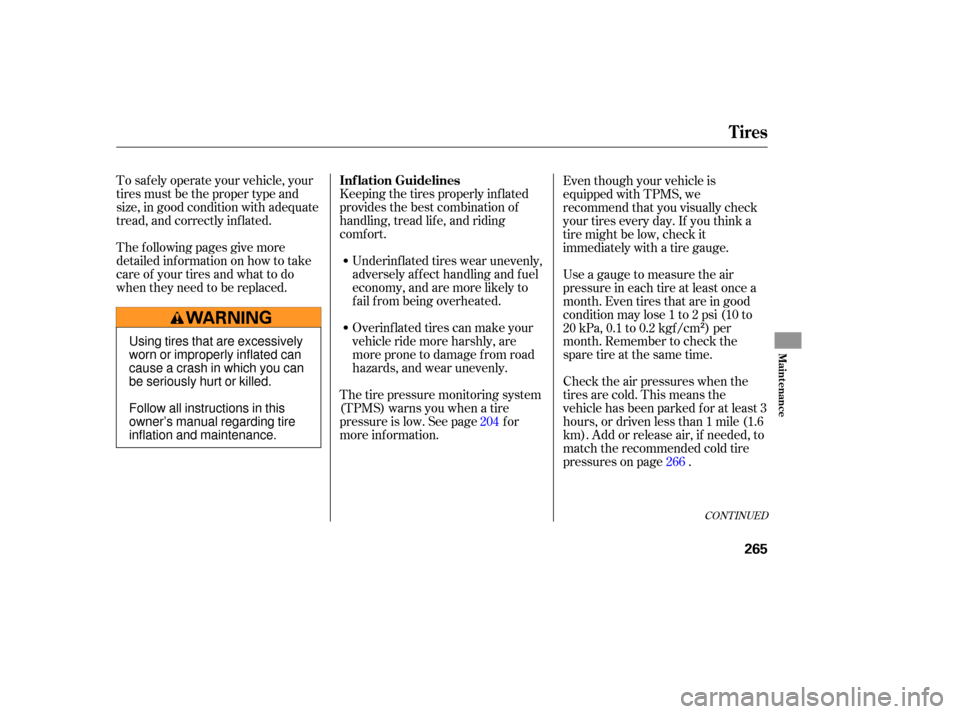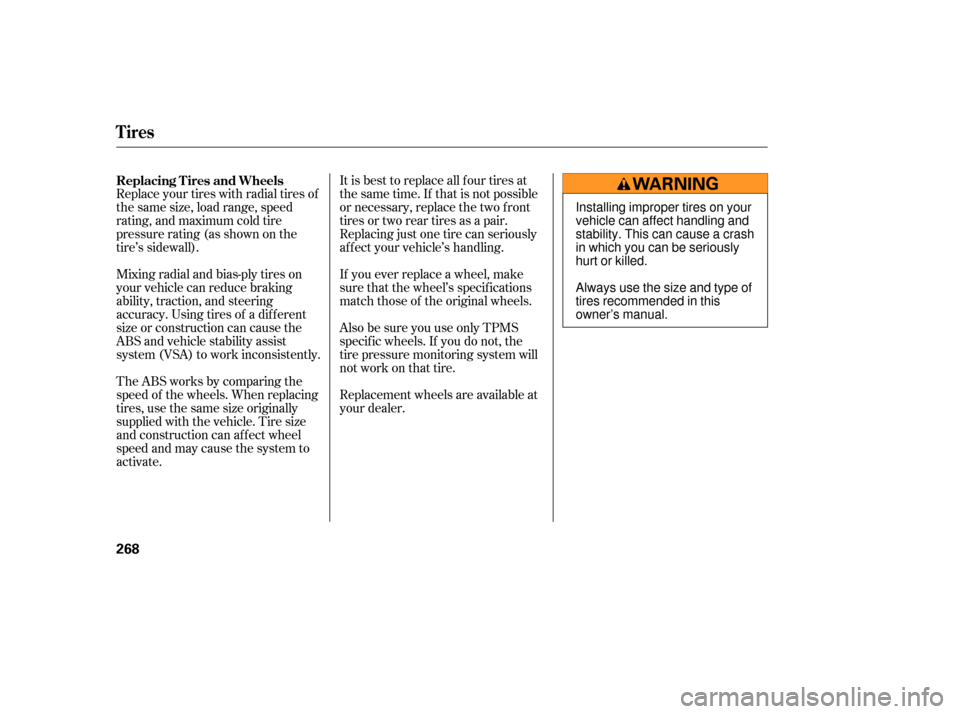Page 232 of 331

Before you leave the pavement, be
sure to do all sch eduled maintenance
and service, and inspect your vehic le
for any problems. Pay special
attention to the condition of the tires,
and check the tire pressures.
After you return to the pavement,
carefully inspect your vehicle to
ma ke sure there is no damage that
could make driving it unsafe.
Recheck the condition of the tires
and the tire pressures.
The
route presents limits (too steep
or bumpy road s). You have limits
(driving skill and comfort). And your
vehicle has limits (traction, stability,
and power).
Driving off-highway can be
hazardous if you fail to recognize
limits and take the proper
precau tions.
To
avoid loss of control or rollover,
be sure to follow all precau tions and
recommendations.
Be sure to store cargo properly
and do not exceed your cargo load
limits (see page and ).
Be aware that a heavy load can
reduce ground clearance and your
ability to clear obstacles.
Whenever you drive, make sure
you and your passengers always
wear seat belts.
Keep your speed low, and never
go faster than the conditions allow.
It’s up to you to continually assess
the situation and drive within the
limits. 187 212
Check Out Your Vehicle
Remember
Important Saf ety Precautions
Of f -Highway Driving Guidelines
228
Page 245 of 331
�µ�µ�µ
�µ
�µ �µ
Youshouldcheckthefollowing
items at the specified interval s. If
you are unsure of how to perform
any check, turn to the appropriate
page listed.
Engine oil level Check every
time you fill the fuel tank. See
page .
Engine coolant level Check the
radiator reserve tank every time
you fill the fuel tank. See page .
Automatic transmission Check
the fluid level monthly. See page
.
Brakes Check the fluid level
monthly. See page .
Tires Check the tire pressure
monthly. Examine the tread for
wear and foreign objects. See page
. Lights
Check the operation of
the headlights, parking lights,
taillights, high-mount brake light,
and licen se plate lights monthly.
See page .
182 182
251 253
265 255
CONT INUED
Maintenance Minder
Owner’s Maintenance Checks
Maint enance
241
Page 269 of 331

To safely operate your vehicle, your
ti res must be the proper type and
size, in good condition with adequate
tread, and correctly inflated. Keeping
the tires properly inflated
provides the best combination of
handling, tread life, and riding
comfort.
The following pages give more
detailed information on how to take
care of your tires and what to do
when they need to be replaced. Underinflated
tires wear unevenly,
adversely affect handling and fuel
economy, and are more likely to
fail from being overheated.
Overinflated tires can make your
vehicleridemoreharshly,are
more prone to damage from road
hazards, and wear unevenly.
Thetirepressuremonitoringsystem
(TPMS) warns you when a tire
pressu re is low. See page for
more information. Even
though your vehicle is
equipped with TPMS, we
recommend that you visually check
your tires every day. If you think a
tire might be low, check it
immediately with a tire gauge.
Use a gauge to measure the air
pressure in each tire at least once a
month. Even tires that are in good
condition may lose 1 to 2 psi (10 to
20 kPa, 0.1 to 0.2 kgf/cm ) per
month. Remember to check the
sparetireatthesametime.
Check the air pressures when the
tires are cold. This means the
vehicle has been parked for at least 3
hours, or driven less than 1 mile (1.6
km). Add or release air, if needed, to
match the recommended cold tire
pressures on page .
204
266
CONT INUED
Inf lation Guidelines
Tires
Maint enance
265
Using tires that are excessively
worn or improperly inflated can
cause a crash in which you can
be seriously hurt or killed.
Follow all instructions in this
owner’s manual regarding tire
inflation and maintenance.
Page 270 of 331

Every time you check inflation, you
should also examine the tires for
damage, foreign objects, and wear.
Youshouldlookfor: Bumps or bulges in the tread or
side of the tire. Replace the tire if
youfindeitheroftheseconditions.
Cu ts, splits, or cracks in the side
of the tire. Replace the tire if you
can see fabric or cord.
Excessive tread wear.
If
you check air pressures when the
tires are hot [driven for several miles
(kilometers)], you will see readings 4
to6psi(30to40kPa,0.3 to0.4
kgf/cm ) higher than the cold
readings.Thisisnormal.Donotlet
air out to match the recommended
cold air pressure. The tire will be
underinf lated.
For additional inf ormation about
your tires, see page . For convenience, the recommended
tire sizes and cold tire pressures are
on a label on the driver’s doorjamb. The following chart shows the
recommended cold tire pressures f or
most normal and high-speed driving
conditions. Never use a puncture-repairing agent
in a f lat tire. If used, you will have to
replace the tire pressure sensor.
Havetheflattirerepairedbyyour
dealer as soon as possible.
Youshouldgetyourowntire
pressure gauge and use it whenever
you check your tire pressures. This
will make it easier f or you to tell if a
pressure loss is due to a tire problem
and not due to a variation between
gauges.
While tubeless tires have some
ability to self -seal if they are
punctured, you should look closely
for punctures if a tire starts losing
pressure. 306
Tire Size Cold Tire Pressure
Compact Spare Front/Rear:
Tires
Tire Inspection
Recommended Tire Pressures
266
P245/65R17 105S 32 psi (220 kPa , 2.2 kgf/cm
)
60 psi (420 kPa , 4.2 kgf/cm
)
T165/90R17 105M
Page 272 of 331

It is best to replace all f our tires at
thesametime.If thatisnotpossible
or necessary, replace the two f ront
tires or two rear tires as a pair.
Replacing just one tire can seriously
af f ect your vehicle’s handling.
If you ever replace a wheel, make
sure that the wheel’s specif ications
match those of the original wheels.
Replace your tires with radial tires of
the same size, load range, speed
rating, and maximum cold tire
pressure rating (as shown on the
tire’s sidewall).
Also be sure you use only TPMS
specif ic wheels. If you do not, the
tire pressure monitoring system will
notworkonthattire.
Mixing radial and bias-ply tires on
your vehicle can reduce braking
ability, traction, and steering
accuracy. Using tires of a dif f erent
size or construction can cause the
ABS and vehicle stability assist
system (VSA) to work inconsistently.
TheABSworksbycomparingthe
speed of the wheels. When replacing
tires, use the same size originally
supplied with the vehicle. Tire size
and construction can affect wheel
speed and may cause the system to
activate.
Replacement wheels are available at
your dealer.
Replacing T ires and Wheels
Tires
268
Installing improper tires on your
vehicle can affect handling and
stability. This can cause a crash
in which you can be seriously
hurt or killed.
Always use the size and type of
tires recommended in this
owner’s manual.
Page 277 of 331

This section covers the more
common problems that motorists
experience with their vehicles. It
gives you inf ormation about how to
safely evaluate the problem and what
to do to correct it. If the problem has
stranded you on the side of the road,
you may be able to get going again.
If not, you will also f ind instructions
on getting your vehicle towed.......................
Compact Spare Tire .274
....................
Changing a Flat Tire .275
.............
If the Engine Won’t Start .283
................................
Jump Starting .284
..............
If the Engine Overheats .286
.........
Low Oil Pressure Indicator .288
..........
Charging System Indicator .288
.......
Malf unction Indicator Lamp .289
...............
Brake System Indicator .290
..............................................
Fuses .291
..............................
Fuse Locations .294
......................
Emergency Towing .296
..........
If Your Vehicle Gets Stuck .297
Taking Care of the Unexpected
T aking Care of t he Unexpect ed
273
Page 278 of 331

Use the compact spare tire as a
temporary replacement only. Get
your regular tire repaired or replaced,
and put it back on your vehicle as
soon as you can.
Check the inflation pressure of the
compact spare tire every time you
check the other tires. It should be
inflated to:
Follow these precautions: Do
not mount snow chains on a
compact spare.
Do not use the compact spare tire
if you are towing a trailer.
Do not use your compact spare
tire on another vehicle unless it is
thesamemakeandmodel.
Replace the tire when you can see
the tread wear indica tor bars. The
replacement should be the same size
and design tire, mounted on the
same wheel. The spare tire is not
designed to be mounted on a regular
wheel, and the spare wheel is not
designed for mounting a regular tire.
Never
exceed 50 mph (80 km/h).
This tire gives a harsher ride and
less traction on some road
surf aces. Use greater caution
while driving. Driving with the compact spare
tiremayactivatetheTPMS(see
page ). The TPMS does not
monitor compact spare tire
pressure.
205
Compact Spare Tire
274
INDICATOR LOCATION MARK
TREAD WEAR INDICATOR BAR
60 psi (420 kPa , 4.2 kgf/cm)
Page 310 of 331

�µ
�µ
�µ
�µ
�µ
�µ �µ
�µ
�µ
�µ
�µ
�µ �µ
The tires that came on your vehicle
have a number of markings. Those
you should be aware of are described
below.
Rim diameter in inches.
Load index (a numerical code
associated with the maximum
load the tire can carry).
Speed symbol (an
alphabetical code indicating
the maximum speed rating).
The tire identif ication number (TIN)
is a group of numbers and letters
that look like the f ollowing example
TIN. TIN is located on the sidewall
of the tire.
Tire construction code (R
indicates radial). Aspect ratio (the tire’s section
height as a percentage of its
width). Tire width in millimeters. Vehicletype(Pindicates
passenger vehicle). Tire type code.
Date of manuf acture.
The maximum air
pressurethetirecan
hold.
Max Press
Max Load The maximum load the
tire can carry at
maximum air pressure.
Whenever tires are replaced, they
should be replaced with tires of the
same size. Below is an example of
tire size with an explanation of what
each component means.
Manuf acturer’s
identification mark.
This indicates that the tire
meets all requirements of
the U.S. Department of
Transportation.
R DOT
B97RFW6X
2202
65 245 P 17
105
S
Tire Labeling
Tire Size
T ire Ident if icat ion NumberMaximum T ire Pressure
Maximum T ire L oad
306
P245/65R17 105S DOT B97R FW6X 2202